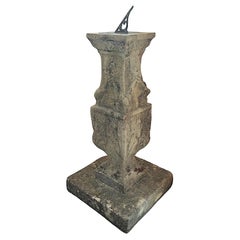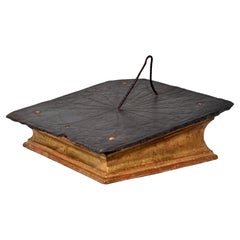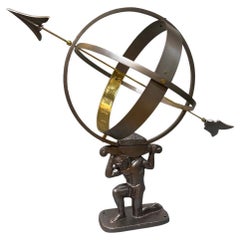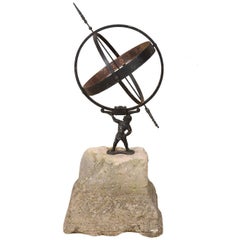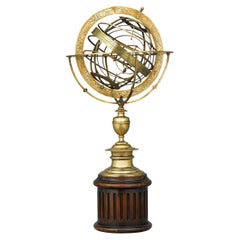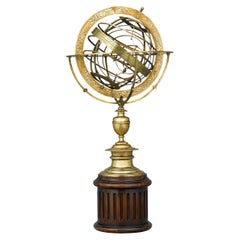17th Century Sundials
to
2
2
Height
to
Width
to
8
18
49
5
11
11
22
1
2
3
2
1
2
1
1
1
1
2
1
2
2
2
Period: 17th Century
Antique Hand-carved Portland Stone and Brass Sundail
Located in Los Angeles, CA
Hand-carved Portland stone pedestal with a brass sundial plate. Base and pedestal, 2 pieces. Late 17th/early 18th century.
Portland stone is a limestone geological formation datin...
Category
British Antique 17th Century Sundials
Materials
Limestone, Brass
17th Century Slate Sundial, Decorated And Dated
Located in San Francisco, CA
A very old slate sundial with iron gnomon on gilt wood stand.
Appears the date is 1654 (but this could be older as the date is hard to make out clearly). Has some old damage around t...
Category
European Antique 17th Century Sundials
Materials
Slate
Related Items
Atlas Armillary Sundial in Pewter Finish with Brass Accents
Located in Stamford, CT
The Greeks have used sundials to measure time since 100 B.C. Reminiscent of classic Greek mythology, this Atlas Armillary Sundial will demand attention, ...
Category
Indian 17th Century Sundials
Materials
Aluminum, Brass
$176 Sale Price / item
20% Off
H 28 in W 27 in D 16 in
Swedish Atlas Armillary Sundial Mounted on Hand-Carved Antique Stone Plinth
Located in Atlanta, GA
A Swedish armillary of Atlas mounted onto stone plinth. This vintage Swedish armillary sundial is supported on the single arm of mighty Atlas, and is...
Category
Swedish 17th Century Sundials
Materials
Stone, Copper, Metal
$5,595
H 45.5 in W 21 in D 16 in
Antique 18th Century George II Limestone Sundial
Located in Wormelow, Herefordshire
An antique mid 18th century George II limestone sundial with a bronze sundial plate. Dating to circa 1750, this striking English sundial showcases an unusual bulbous shape on an impr...
Category
English Georgian Antique 17th Century Sundials
Materials
Stone, Limestone, Metal, Bronze
Carved Italian Marble Sundial with Iron Gnomon
Located in Dallas, TX
Hand-carved in Italy, this beautiful marble sundial has a turned iron gnomon that mirrors a thin twisted rope molding along the outer edges. Beneath the gnomon attachment are colored inserts that form a blue, red, yellow, and green compass rose, providing a colorful contrast to the cream marble with subtle tan and gray veining.
As the earth rotates on its axis, the gnomon casts a shadow onto the marble which is incised with Roman Numerals on a stylized scroll. Directly under the tip of the angled gnomon is “XII”, indicating noon. The numbers to the left of XII run counterclockwise, starting with “VI”. On the opposite side, the numerals continue in a counterclockwise manner, terminating in a second “VI” (which would be PM if the sundial...
Category
Italian 17th Century Sundials
Materials
Marble, Iron
Vintage Cast & Carved Stone Spanish Garden Sundial
Located in Port Jervis, NY
Fabulous large Unusual form cast & carved stone Spanish Garden sundial. Cast and imprinted with its makers name & date (1938), this will enhance all gardens that it graces. Roman num...
Category
American Greco Roman Vintage 17th Century Sundials
Materials
Cast Stone, Iron
Antique Swedish Sundial
Located in Hollywood, FL
This is a Antique Swedish Sundial in original condition.
Category
Swedish Primitive Vintage 17th Century Sundials
Materials
Concrete, Metal
English Mid Century English Bronze Sundial
Located in Wormelow, Herefordshire
An antique mid century modern English bronze sundial.
Suitable for interior and exterior use, this sundial has an impressive sculptural quality with a robust form, elongated gnome a...
Category
English Mid-Century Modern 17th Century Sundials
Materials
Metal, Bronze
Antique Victorian English Medieval Styled Solid Bronze Architectural Sundial
Located in Hamilton, Ontario
Presumably having English origins, this antique solid bronze sundial is ornately cast with a series of Medieval figures across the top portion and standing in the facade of an arched...
Category
English Medieval Antique 17th Century Sundials
Materials
Bronze
$2,950
H 11.45 in W 13.5 in D 4 in
Austin & Seeley Gothic Style Armillary Sundial
By Austin & Seeley
Located in Wormelow, Herefordshire
A striking focal point for any garden, this impressive sundial pairs a mid 19th century gothic style stone pedestal by Austin and Seeley (unsigned) circa 1840, with a 20th century steel armillary sphere.
Coupling composition stone intricacy with a contemporary armillary, this garden sundial offers a beautiful blend of antique and modern, perfect for instilling a courtyard or patio with history and interest.
This gothic style pedestal appears in appears in Austin & Seeley’s catalogue dated 1841 (pictured). Here it is described as a ‘Rich Gothic Font, designed from Henry VII’s Chapel’ of Westminster Abbey, London. The drawing also appears in an advertisement from The Civil Engineers and Architects Journal 1839 (pictured), suggesting that this stone pedestal could date from even earlier.
Austin and Seeley works were rarely stamped with makers marks.
Austin & Seeley
In 1828, Felix Austin established his own independent stone works...
Category
English Gothic Antique 17th Century Sundials
Materials
Stone, Composition, Metal, Steel
Antique Art Nouveau Glazed Stoneware Sundial
Located in Wormelow, Herefordshire
An elegant antique art nouveau glazed stoneware sundial circa 1900, likely Doulton or Leeds Fireclay Company (LEFCO). This sundial was reclaimed from a garden in Suffolk.
With its a...
Category
English Art Nouveau 17th Century Sundials
Materials
Stoneware
Reclaimed Neoclassical Style Armillary Sundial
Located in Wormelow, Herefordshire
Add style to your garden with this reclaimed neoclassical style armillary sundial. It features a steel late 20th century garden armillary sphere above an early 20th century limestone...
Category
English Georgian 17th Century Sundials
Materials
Stone, Limestone, Metal, Steel
Bronze Armillary Sundial on Cast Stone Base
Located in Newtown, CT
Bronze Armillary Sphere on a Cast Stone Base. Together it is 60" high and 32" wide at the arrow. The armillary sphere is 24" wide. Together they weigh approx. 240lbs. The sundial...
Category
American Early Victorian 17th Century Sundials
Materials
Cast Stone, Bronze
Previously Available Items
17th Century Armillary Sphere
Located in New Orleans, LA
This exceptional Italian brass armillary sphere dates to the 17th century - exceedingly rare for an armillary sphere of this size. Though other armillary spheres were often construct...
Category
Antique 17th Century Sundials
Materials
Brass, Bronze
17th-Century Armillary Sphere
Located in New Orleans, LA
This exceptional Italian brass armillary sphere dates to the 17th century - exceedingly rare for an armillary sphere of this size. Though other armillary spheres were often construct...
Category
Antique 17th Century Sundials
Materials
Brass, Bronze
Early Equatorial Sun Ring Dial
Located in New Orleans, LA
A unique and beautiful melding of science and art, this early equatorial sun ring dial is a treasure of horological design. Crafted of a gorgeous pair of brass and bronze rings, this elegant ring dial is suspended to allow sun to shine through the small hole in its bridge, the beam indicating the hour. Made of brass, the Meridian ring features an engraved degree scale divided clockwise from 0 degrees to 90 degrees. The equatorial ring, made of bronze, is engraved on the observed side with 24-hour division, and, on the reverse, beautifully engraved scrollwork displays the geographical declinations of several European cities. The bridge of the ring dial is engraved with zodiac symbols on one side and initials of the months on the reverse.
Invented by British mathematician William Oughtred in the mid-17th century, the two-ring universal equatorial sun ring dial was developed from an earlier astronomical instrument used to measure the altitude of stars. In his writings on mathematical recreations, the model was referred to by Oughtred as the "Horizontall Dyall" and "Horologicall Ring", and boasts the advantage of being self-orienting. Diminutive, portable sundials...
Category
German Other Antique 17th Century Sundials
Materials
Brass, Bronze
Rare Portuguese marble scratch sundial, late 18th Century
Located in Petworth, West Sussex
Reputedly of royal provenance. The top with cherubs flanking an urn, below the dial a large palmette, on a breakfront column base.
Category
